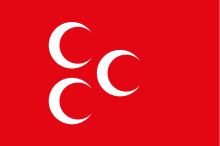Right-wing extremism in Turkey

Right-wing extremism in Turkey is an ideology that is currently represented primarily by the Nationalist Movement Party ( Milliyetçi Hareket Partisi , MHP) and the Great Unity Party ( Büyük Birlik Partisi , BBP). The members and supporters of the MHP are known as gray wolves . The origin of the ideology lies in the late 19th century , when European Turkologists formulated the concept of a Turanid race and a Turanian empire and this ideology was introduced into the politics of the Ottoman Empire by leading young Turks .
history
Turkish right-wing extremism was based on Turkish nationalism and Turanism , which first found supporters in the Ottoman Empire in the 19th century. As a result of the policy of pantürkisch oriented Three Pasha came in 1915 for the Armenian genocide , the genocide of the Assyrians and the massacre of the Pontic Greeks .
After the founding of the republic, Turkish right-wing extremism was originally a neo-pagan movement, which was more strongly reshaped Islamic in particular by the influence of Alparslan Türkeş . The 1930 Fascist Italy under Benito Mussolini executed criminal reforms in the in the Italian Penal Code of 1889 ( Code Zanardelli ) based Turkish Penal Code adopted by the 1926th The “National Turkish Student Union - MTTB” was set up to educate young people in the spirit of racist ideology.
There was a National Socialist group in Izmir in 1969 when a group of former CKMP members (predecessor party of the MHP) founded the association “Nasyonal Aktivitede Zinde İnkişaf” (NAZİ). The club had two combat units. The members wore SA uniforms and used the Hitler salute. One of the leading members (Gündüz Kapancıoğlu) was re-admitted to the MHP in 1975.
History of ideas
Türkeş developed the doctrine of the nine lights (9 Işık Doktrini) as an ideological basis. These lights are nationalism, idealism, sense of honor, science, unity, peasantry, freedom and self-reliance. The common denominator is excessive nationalism and pronounced Islamic piety. The goal is the ideal of founding a Greater Turkey, sometimes even the unification of all Turkic peoples of the world in one state ( Turanism or Pan-Turkism ). In the 1970s, anti-communism was also a defining characteristic of Turkish right-wing extremists. Capitalism is also often rejected. Instead, a “third way” is favored, a community with a strong leader whose defining characteristic is the Turkish-Islamic identity. Classical enemy images are Freemasons, "Zionists" and the PKK . Anti-Semitic stereotypes are widespread in all political directions in Turkish society. Turkish right-wing extremists are also hostile to minorities. An important concern of this group is the situation of the so-called “Turks abroad”, meaning the Uyghurs in Xinjiang .
Turkish right-wing extremism is based on a sense of the superiority of Turkish culture and a glorification of Turkishness. Ethnic racism is denied. Highly revered personalities among Turkish right-wing extremists are Alparslan Türkeş († 1997), Necip Fazıl Kısakürek († 1983), Ozan Arif , Ziya Gökalp († 1924), Munis Tekinalp († 1961) and also, for example, the racist Nihal Atsız († 1975) However, especially at an advanced age, he represented a pronounced Islamophobic worldview.
Terms
Right-wing extremism, which is very Islamic today, is often summarized under the term Turkish-Islamic synthesis or referred to as "Ülkücülük" (idealism). The followers of the movement are called "Bozkurtlar" or "Bozkurtçular" (gray wolves or followers of the gray wolves). In contrast to right-wing extremism, religious fundamentalism is pejoratively referred to as “irtaca” or “gericilik”, which, like right-wing extremism, is partly anti-Semitic.
Symbols
The symbols of Turkish right-wing extremists are mostly pre-Islamic. These include the wolf, who plays a central role in the myth of Turkish descent, the Asena legend . Turkish right-wing extremists raise their hands in a wolf salute. There are also the pre-Islamic symbols of the three crescent moons or the crescent moon with a star (Ayyıldız). Pre-Islamic Turkish runic characters or Islamic calligraphy are popular. Characteristic for this group is the so-called idealist oath (Ülkücü Yemini), in which one swears to fight for Turan to the last drop of blood.
Assaults
Anti-minority attacks or pogroms have come and continue to occur in Turkey, for example the pogroms in Thrace , Istanbul , Çorum , Maraş and the arson attack on Sivas . The Black Sea region and the region around Sivas are considered regional strongholds of right-wing extremist tendencies. Before the military coup in 1980, numerous political murders were carried out by right-wing extremists.
Todays situation
In the 2007 parliamentary elections , the far-right achieved Nationalist Movement Party 14.3% of votes in the elections in 2011 13%. It has an offshoot in Germany, the Federation of Turkish Democratic Idealist Associations in Germany . Another right-wing extremist party is the Büyük Birlik Partisi .
For the parliamentary election on June 24, 2018, the MHP ran in an alliance with the AKP. It won 11.1% of the vote and 49 seats.
literature
- Fikret Aslan and Kemal Bozay : Gray wolves are howling again: Turkish fascists and their networking in the FRG . Unrast Verlag , Münster 2000, ISBN 3-89771-004-8 .
Individual evidence
- ^ Arminius H. Vambéry: Travels in Central Asia 1871 . Page 485ff.
- ↑ Christian Rumpf: Introduction to Turkish Law . CH Beck, Munich 2004, ISBN 978-3-406-51293-3 , p. 391.
- ↑ Kemal Bozay : The Turkish Right on the Up, History and Current Issues , The Right Edge , No. 75 from March / April 2002, p. 15 ff.
- ^ Jürgen Roth and Kamil Taylan: Turkey - a republic among wolves . Bornheim-Merten, page 119.
- ^ Faruk Şen : Turkey - Country and People . Munich 1986, page 110.
- ↑ Klaus Kreiser : Brief history of Turkey. Stuttgart 2003, p. 437.
- ↑ Katy Schröder: Turkey in the shadow of nationalism. Hamburg 2003, p. 118.
- ^ AKP, MHP to press button for 'People's Alliance'. Retrieved April 3, 2018 .
- ↑ 24 Haziran 2018 Genel Seçim Sonuçları. Retrieved July 4, 2018 .
